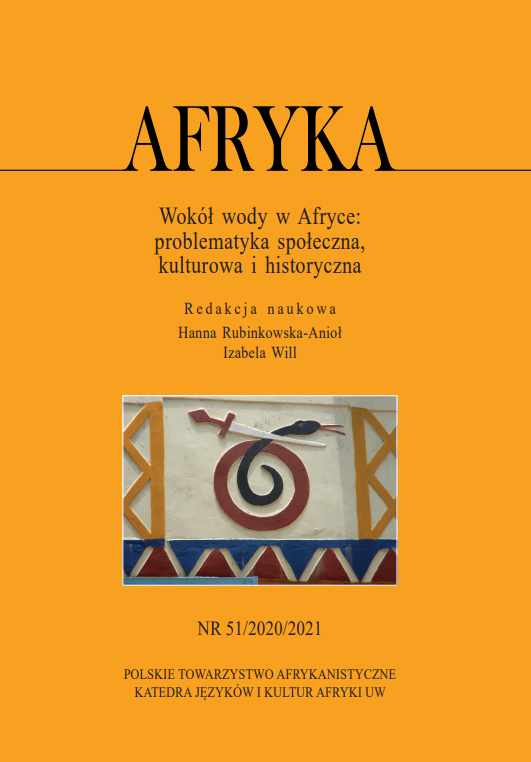Opublikowane 2022-04-16
Słowa kluczowe
- zasoby wodne,
- żegluga śródlądowa,
- nawadnianie,
- rybołówstwo śródlądowe
Abstrakt
W pracy przedstawiono wybrane zagadnienia związane z wodami powierzchniowymi Afryki kontynentalnej. W pierwszej części scharakteryzowano główne rzeki, jeziora, obszary wodno-błotne i zaporowe zbiorniki wodne, a w drugiej zarysowano ich znaczenie dla rolnictwa, rybołówstwa i żeglugi śródlądowej. Dane zaczerpnięto z literatury, rocznika statystycznego FAO oraz baz danych: Aquastat, World Waterfalls Database oraz Global Lakes and Wetlands Database. W Afryce występują największe na świecie systemy rzeczne (Nil, Kongo), jedne z największych na świecie jezior (Jezioro Wiktorii, Tanganika), największe na świecie obszary wodno-błotne (Sudd, delta Okawango, delta wewnętrzna Nigru) oraz zaporowe zbiorniki wodne należące do największych na świecie (Wolta na rzece Wolta i Kariba na Zambezi). Zasoby wodne są jednak nierównomiernie rozmieszczone i zależne od zmienności opadów w skali krótko- i długoterminowej. Obok regionów z dużymi możliwościami nawadniania pól wodami rzek oraz rozwoju rybołówstwa i żeglugi śródlądowej, w Afryce występują regiony z drastycznie niskimi zasobami wód powierzchniowych. Zmiany klimatu w sprzężeniu z rosnącą populacją kontynentu jeszcze bardziej te dysproporcje pogłębią.
Bibliografia
- Alsdorf, Douglas et al. 2016. „Opportunities for hydrologic research in the Congo Basin”. Reviews of Geophysics 54, 378–409.
- Avery, Sean. 2018. „How Ethiopia and Kenya have put a world heritage site in danger”. The Conservation UK, July 8.
- Baijot, Etienne; Jaques Moreau; Sana Bouda. 1997. Hydrobiological aspects of fisheries in small reservoirs in the Sahel region. Wageningen: Technical Centre for Agricultural and Rural Cooperation.
- Barakagira, Alex; Anton H. de Wit. 2019. „The role of wetland management agencies within the local community in the conservation of wetlands in Uganda”. Environmental & Socio-economic Studies 7, 1, 59–74.
- Beilfuss, Richard; David dos Santos. 2001. „Patterns of hydrological change in the Zambezi delta, Mozambique”. Program for the sustainable management of Cahora Bassa Dam and the Lower Zambezi Valley. Working Paper 2, 1–152.
- Bonnerjee, Sobhanlal et al. 2009. Inland waterborne transport: Connecting countries. Paris: United Nations Educational, Scientific and Cultural Organization, UNESCO.
- Bourma, Arrakhais A. et al. 2017. „Contribution to knowledge of the Lakes of Ounianga by bathymetry and physicochemistry”. International Journal of Water Resources and Environmental Engineering 9, 10, 218–225.
- Chudzik, Patryk; Mateusz Żmudziński. 2017. „Rola Nilu w kształtowaniu kultury starożytnego Egiptu”. Prace Kulturoznawcze 21, 3, 13–25.
- Coe, Michael T.; Jonathan A. Foley. 2011. „Human and natural impacts on the water resources of the Lake Chad Basin”. Journal of Geophysical Research 106, D4, 3349–3356.
- Czeppe, Zdzisław; Jan Flis; Rodion Mochnacki. 1969. Geografia fizyczna świata. Warszawa: Państwowe Wydawnictwo Naukowe.
- FAO. 2017. AQUASTAT Main Database. Food and Agriculture Organization of the United Nations (FAO).
- FAO. 2020. World food and agriculture – Statistical Yearbook 2020. Rome.
- Funge-Smith, Simon. 2018. „Review of the state of the world fishery resources: Inland fisheries”. Fisheries and Aquaculture, FAO Circular, C942, Revision 3.
- Geheb, Kim et al. 2008. „Nile perch and the hungry of Lake Victoria: Gender, status and food in an East African fishery”. Food Policy 33, 85–98.
- Goudie, Andrew S. 2005. „The drainage of Africa since the Cretaceous”. Geomorphology 67, 437–456.
- Kite, G.W. 1981. „Recent changes in level of Lake Victoria”. Hydrological Sciences Journal 26, 3, 233–243.
- Kröpelin, Stefan. 2009. „Lakes in the Sahara”. German Research 2, 9.
- Makowski, Jerzy. 2006. Geografia fizyczna świata. Warszawa: Wydawnictwo Naukowe PWN.
- Mydel, Rajmund; Jerzy Groch, (red.). 1998. Przeglądowy atlas świata. Afryka. Kraków: Fogra Oficyna Wydawnicza.
- Nicholson, Sharon. 2000. „The nature of rainfall variability over Africa on time scales of decades to millennia”. Global and Planetary Change 26, 1, 137–158.
- Orange River. 2020. https://en.wikipedia.org/wiki/Orange_River, dostęp z dnia 15 września 2020.
- Osuagwu, Eze S.; Eseoghene Olaifa. 2018. „Effects of oil spills on fish production in the Niger Delta”. PloS One 13, 10, e0205114.
- Ramsar Convention. 1971. „Convention on wetlands of international importance especially as waterfowl habitat”. Ramsar, Iran, 1–6.
- Ramsar List. 2020. The List of wetlands of international importance.
- Rebelo, Lisa-Maria; Asim I. El Moghraby. 2018. „The Sudd (South Sudan)”, w: C.M. Finlayson et al. (red.), The wetland book. Dordrecht: pringer, 1299–1306.
- State of the River Nile Basin. 2012. Entebbe: Nile Basin Intitative.
- Sutcliffe, John; Emma Brown. 2018. „Water losses from the Sudd”. Hydrological Sciences Journal 63, 4, 527–541.
- Termiński, Bogumił. 2013. „Wysiedlenia inwestycyjne: przyczyny, konsekwencje i kontekst prawny”. Revista Europea de Derecho de la Navegación Marítima y Aeronáutica 30, 79–118.
- UNEP. 2010. Africa water atlas. Nairobi: Division of Early Warning and Assessment (DEWA). United Nations Environment Programme (UNEP).
- Volta River. 2020. https://en.wikipedia.org/wiki/Volta_River, dostęp z dnia 15 września 2020.
- Witte, Frans et al. 2008. „The fish fauna of Lake Victoria during a century of human induced perturbations”, w: J. Snoeks, A. Getahun (red.), Proceedings of the Fourth International Conference on African Fish and Fisheries, Addis Ababa, Ethiopia. Tervuren: Royal Museum for Central Africa, Zoological Documentation Online Series, 49–66.
- World Waterfalls Database. 2020. https://www.worldwaterfalldatabase.co
- WWF. 2004. Global Lakes and Wetlands Database. World Wildlife Found. Washington. http://www.wwfus.org/science/data.cfm
